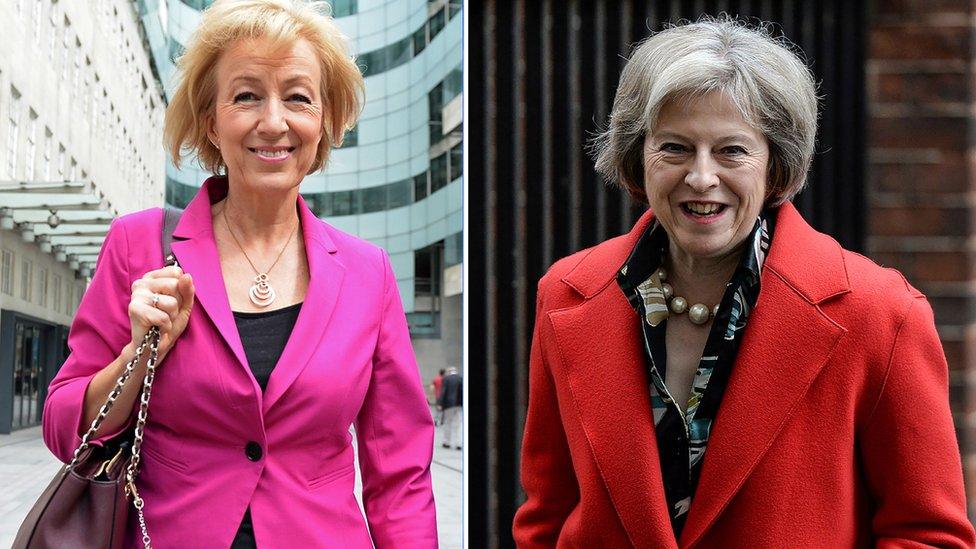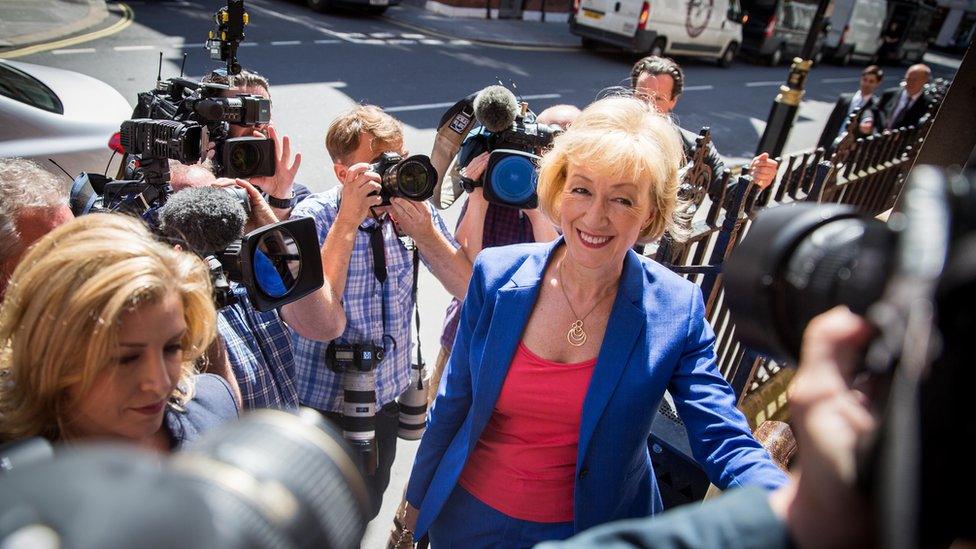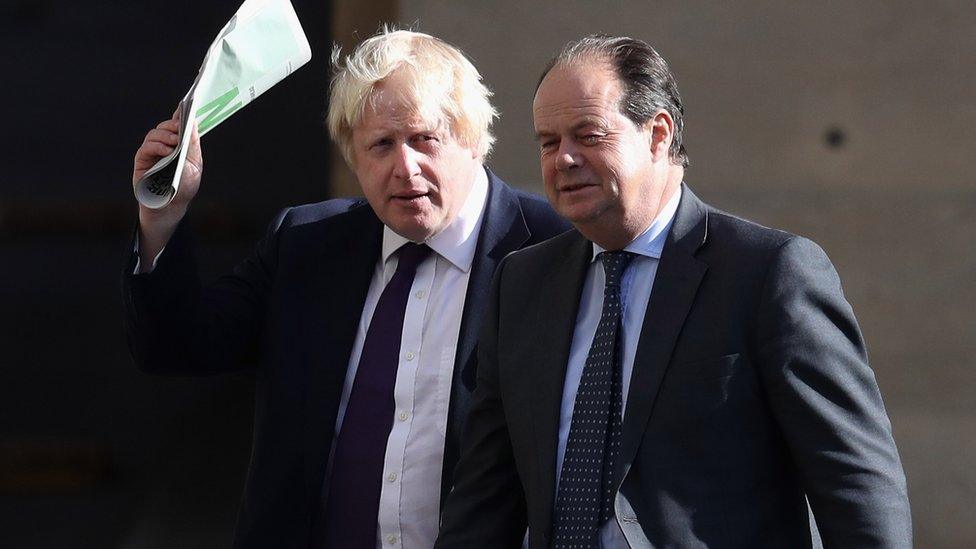Tory leadership race renews historic battles
- Published

Andrea Leadsom and Theresa May are figureheads for two different Conservative visions
Now we know. The name of Britain's next prime minister will be either Andrea or Theresa.
Two women. Two Tories. Two potential leaders who - whether they like it or not, whether the country likes it or not - are destined to be dubbed the new Maggie.
That though is where the similarities between May and Leadsom end.
One - of course - made the case, ever so quietly, for Remain. The other argued, ever so passionately, for Leave.
One is highly experienced - the longest-serving home secretary for more than a century. The other would be the least experienced prime minister this country has had since Pitt the Younger.
Not only has Andrea Leadsom had no Cabinet experience. Unlike David Cameron or Tony Blair she has not served an apprenticeship as leader of the opposition.
But this run-off is about much more than that. May and Leadsom are figureheads for two very different visions of Conservatism, backed by different factions which have been at war in the party for a quarter of a century.
Blue thread
Yesterday Andrea Leadsom's backers marched on Westminster.
The sound of besuited ministerial Tories chanting, "What do we want? Leadsom for leader," may seem a little incongruous.
Theresa May v Andrea Leadsom to be next prime minister
But it was - in truth - the perfect symbol of the fact that she and her backers see themselves as part of a peasants' revolt against the Tory establishment and David Cameron's project of Tory modernisation.
Sam Coates, deputy political editor of The Times, explains that Andrea Leadsom does not really have a tribe of her own but figures the traditional Tory right has adopted her as their best hope of getting into power.
"You will see some similarities in her campaign team going back all the way to 1995 when John Redwood tried to oust John Major from Downing Street," says Coates.
"You will also see some similarities in 2001 when Iain Duncan Smith went for the Tory crown successfully, only to be thrown out three years later. So there is a strand that runs through the Conservative Party stretching back 20 years."
Thatcherite approach
Leadsom's overt pitch is that she is a true BeLeaver - an optimist about Britain's future, rather than a reluctant convert to the cause of Brexit.
Beneath this, though, she is seeking to build a coalition of those many Tory activists who David Cameron has antagonised over the past decade as his party's leader.
Those who objected to gay marriage, who are resisting the building of HS2, those who want to see a vote to lift the legal ban on fox hunting, those who want a more radical, a more resolute, a more Thatcherite approach.

Andrea Leadsom advocated dropping all regulation for the very smallest companies
Four years ago, Leadsom urged the government to take a very different approach to workers rights' for companies with three or fewer employees
She said: "I could envisage a situation where you had no regulation whatsoever, no minimum wage, no maternity or paternity rights, no unfair dismissal rights, and no pension rights - absolutely no regulation whatsoever for the very smallest companies that are trying to get off the ground."
'Nasty party'
If that speech is one reason the Tory right warms to Andrea Leadsom, another much more famous speech explains why they are suspicious of Theresa May when she told the Tory conference in 2002 they were seen as the "nasty party".
"I know that's unfair, you know it's unfair but it's the people out there we need to convince," she said.
"And we can only do that by avoiding behaviour and attitudes that play into the hands of our opponents. No more glib moralising, no more hypocritical finger-wagging, we need to reach out to all areas of our society."

Theresa May has a coalition of supporters from different wings
That speech is what convinced some in her party that May is too politically-correct, too establishment, too cautious.
Sam Coates says May does not really have a tribe of her own.
"Once upon a time she was a moderniser, she rather shed that image when she was home secretary and the people standing behind her are a kind of odd, loose coalition of people who work with her, people who are careerists and people drawn from the wing of the party who consider themselves to be pragmatists."
Brexit divisions
Theresa May does - though - have the overwhelming support of Tory MPs, strikingly she has the backing of newspapers as diverse as the Mail and The Mirror and The Sun.
So, say some, she's sure to win but, remember, that's what they said about the referendum, that's what they said before Boris Johnson endorsed Brexit, as he is now endorsing Leadsom.

Boris Johnson is cheering for Andrea Leadsom
Johnson was clearly not impressed by Theresa May's declaration that Brexit means Brexit. He knows... she knows that the truth is much more complex than that.
Brexit - May says - will take time, will be complex, will need an experienced negotiator.
Brexit - Leadsom implies - needs to be delivered fast, should be embraced and treated with hope and not fear.
Who should the country be ready for? That question will soon focus on much, much more than simply the choice between two different women.